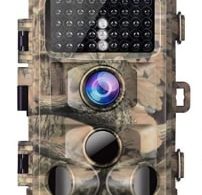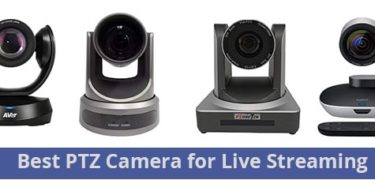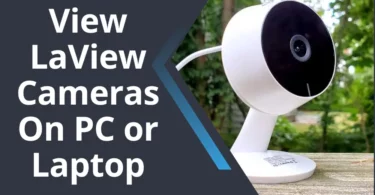As an Amazon Associate, I can earn from qualifying purchases. Learn more.
When we speak of CCTV technology, you’ll come across so many brands and models that you need to choose from. For today, we’re going to look at the difference between NVR and DVR systems to determine which is worth investing in.
The two are usually under what we call expandable surveillance systems as you can hook up multiple cameras to “expand” the coverage. But then, each has unique strengths, downsides, and features that stand it out from the other. So, it’s very important to know all from either side in advance if you’re to make the most from whichever you get.
DVR vs NVR: What Exactly Are They?
First of all, a DVR is an acronym for a digital video recorder, whereas NVR stands for the network video recorder. They are like the heart of the expandable or else multichannel security camera systems.
If you’re new to video surveillance, it’s very easy to be conned into buying a DVR when you wanted an NVR, or vice versa. When viewed from the front, they both look like a set-top box or closer to the VCR player that was the “Netflix” of the ‘80s and ‘90s.
However, a DVR does look like a TV set-top box even on the back because of the RCA connectors for the video. It carries the video signal from the cameras over a coaxial BNC cable, then processes it for recording before storing or sending it to the monitor.
Meanwhile, an NVR has Ethernet ports that UTP/ network cables plug into to communicate with respective PoE security cameras. But unlike DVR, a network recorder catalogs and stores video the cameras send without needing any processing.
Another thing, an NVR can also take the form of a wireless security camera system, in which case it has a built-in point-to-point (P2P) signal. Hence, connecting with its paired cameras without the use of cables. A good example is the Hisseu WNKIT-4HB612, which has an 8-channel NVR that auto-pairs with the cameras with its “own WiFi”. That’s what manufacturers call this P2P connection.
What’s the Difference between NVR and DVR?
When trying to compare DVR vs NVR security camera systems, there’re several features you must consider. They include:
- The type of cameras used
- How the system interprets the Video
- How the cameras get power
- How the cameras send Audio
- What other Extra capabilities are available?
The Type Of Cameras Used
An NVR can operate with two types of IP (internet protocol) cameras:
- PoE IP cameras: This is a type of wired cameras that use Ethernet or networking cable to communicate with a recorder
- Wireless IP cameras: for this one, it can either be a camera with a built-in P2P connection or WiFi connectivity.
The best part of these types of cameras is that they have a built-in chipset for capturing and encoding videos. So, you can enjoy newer intelligent video analytics and image processing tweaks, as well as use an individual camera as a standalone.
Meanwhile, a DVR recorder operates with what we call analog resolution CCTV cameras and HD security cameras (e.g. HDCVI). But these cameras lack the kind of hardware IP cameras possess. So, the DVR is where that chip encodes or otherwise “processes” analog video data arriving from the cameras.
It’s also worth noting that DVR requires cameras higher than 1080p to record at lower frame rates. Coaxial cables were not designed for heavy bandwidth or data, thus you have to optimize if you want to record in high resolution. For instance, you can find a 4K HD coax camera that supports only 7 to 15fps recording mode.
How The System Interprets The Video
As said already, neither DVR nor NVR translates the camera’s video signal like the other. With an NVR, the connected camera usually sends digital video that it has already encoded or otherwise “created”. So, the work of the recorder will only be storing and sending to the viewing monitor.
On its end, a DVR recorder completes processing the video data with the integrated hardware chip before compressing and storing it in the hard drive. But then, how does this differ with an NVR that receives ready video data?
Well, when the DVR is converting the analog video signal to digital, the image quality will lose some pixels in the process. So, the clarity won’t be as sharp as that of an IP camera that records ready digital images. It even will pixelate further when you try to zoom.
Another thing, analog video signals have a higher risk of hacking since it lacks strong encryption as that digital security cameras have.
How The Cameras Get Power
As you decide on whether to have a DVR or NVR system, how you plan to run the installation is very crucial. If you don’t want to spend another $500 on a professional installer, consider a network recorder. PoE (Power over
Ethernet) cameras are pretty convenient as the cable they use transmits both data and power. Hence, eliminating the need of taking power sources closer to individual cameras.
Regardless, wireless IP cameras might need you to bring them power, but their point-to-point communication has plug-and-play compatibility. So the installation and configuration are a breeze as there are fewer to no wires to work with.
Meanwhile, a DVR connects to the BNC cameras via coaxial cables, which carry each data on its separate path. If it’s about power, you’ll need to have a power outlet nearby the mounted camera or run over the Siamese cable.
Simply, a Siamese cable tries to imitate the versatility of PoE technology so that you can run a single cable to the analog camera. However, this cable still has a separate coax cable and a power cable in one jacket. So, you’ll still need to connect to a DC charger or power distribution box for the camera to come online.
Therefore, it’s safe to say a DVR requires no haste to set up, and you might need a hand to wind up faster.
How The Cameras Send Audio
While not all states approve it, a security camera system with audio can be very helpful for monitoring purposes.
If using an NVR, the network cable connecting to the camera carries all the data, including video and audio functions. When we speak of audio functions, we don’t just mean capturing the sounds of objects in the background but also two-way talk if the IP camera in question supports it.
Meanwhile, the coaxial cable that analog CCTV and HD cameras communicate with DVR only captures video data. Even with the advanced HDCVI camera that has a built-in microphone, you must connect the RCA audio input to hear people talking.
If the particular camera doesn’t have audio functions but would want to add a stand-alone microphone, the setup can be kind of boring. This is so as you’ll need to give all the connected devices power, not limited to the DVR, all cameras, and the microphones attached. It even gets more vexing and tiring if you would like to also have an add-on speaker to the recorder.
What Other Extra Capabilities Are Available?
Despite the name, analog CCTV cameras are slowly advancing. Of course, the creators still have a long hill to climb but there has been a massive step up in recent years. One of the security camera firms that has held dear to this technology is Swann. Even after 30 years, the Australian-born brand makes more DVR systems than NVR.
As a true innovator, this company has also proven even analog can be decent and smarter. You can get a camera with True Detect (smart PIR) motor detection, Alexa integration, smart alarm, and warning lights.
When we check a brand like Heimvision, they mostly make NVR (both wired and wireless) but do produce some cool DVR as well. With the Heimvision HM245, for instance, there’s a privacy mask function, face detection, human detection, and smart motion detection. However, the recorder is an 8-channel model but you can also connect another four IP cameras. So, the system is no a regular DVR but instead a Hybrid to help you upgrade to IP equipment at your own pace.
That said, however, the NVR camera system is the best choice if your project requires the application of analytics. It’s far much easier to find a CCTV with advanced analytics like facial recognition, people counting, motion capture zones, video tampering, 2-way audio, and package detection.
Furthermore, a PTZ Outdoor security camera usually has PoE or wireless WiFi technology, which still calls for an NVR.
So, which is better, DVR or NVR
At this point, we can together agree DVR and NVR are great options for security. If it’s image quality, both CCTV systems support up to 4K Ultra-HD, though some PoE cameras now have up to 12MP. On the other hand, analog CCTVs are more affordable from their reduced feature set and also lower costs of production. Hence, a great option when you have less budget but need a great system to monitor a large area.
In any case, the following table summarizes the NVR vs DVR pros and cons. It includes those we have discussed in the article in details, as well as the not-so-
| Network Video Recorder System (NVR) | Network Video Recorder System (NVR) | Digital Video Recorder System (DVR) | Digital Video Recorder System (DVR) |
| Pros | Cons | Pros | Cons |
| Records in rich quality Requires fewer cables Supports two-way audio Easy and quick to install Can connect wired/ wireless cameras Records encrypted video Has high frame rate Supports up to 12MP Has many video analytics | Higher initial cost Can be a trick to troubleshoot Has high bandwidth needs Requires more storage space | Has lower initial costs Effortless to operate Easy to repair Has lower bandwidth requirements Can connect IP cameras Available in many design options | Requires a lot of wiring Lacks security encryption Has limited frame rate |
Final Thoughts:
From the table, it’s clear an NVR has more positives than a DVR system. The use of the network cable and the advanced hardware built into IP cameras has made it possible to record clearer and securer footage. Then, if you would want to monitor high traffic areas, you can easily get a PoE security camera system that supports up to 4K @ 30fps.
But again, a PoE NVR security camera system can be a little expensive, especially if you’re eyeing a high-resolution model. So, you’ll either need to start small with something like a 4-channel security camera system or else get a Hybrid DVR that you can connect BNC and IP cameras.
A sweet trick with some of these Hybrid DVRs even lets you take over the existing BNC channels and use with IP cameras. You just need to get a good PoE switch or else connect with your home router if you have enough internet speeds.



